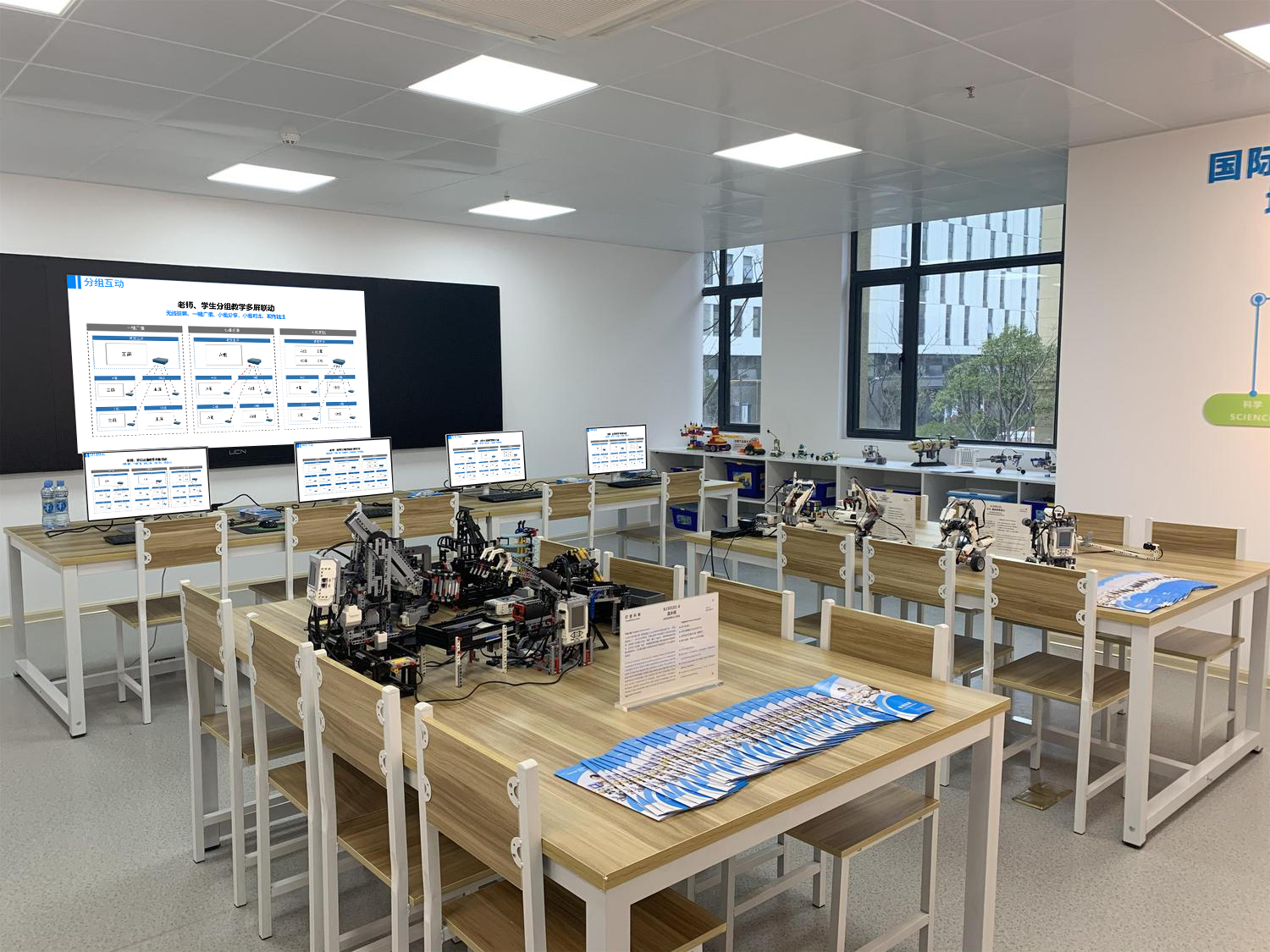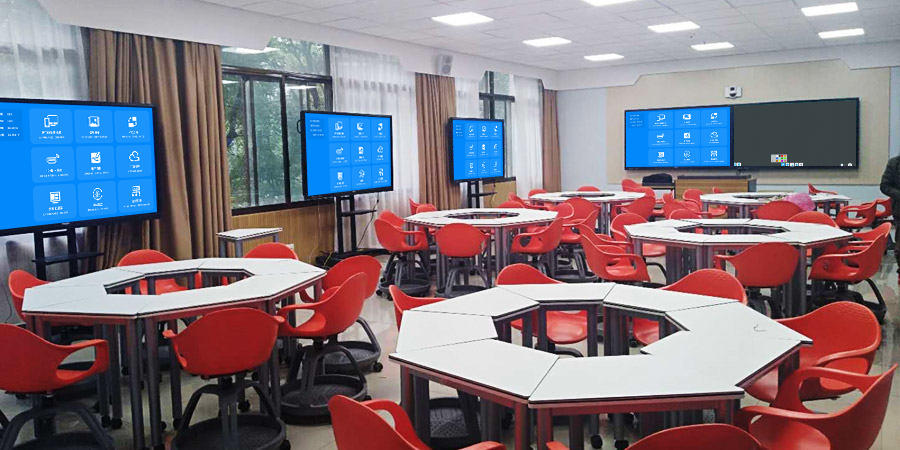Smart Classrooms: Transforming the Classroom from One-Way Output to Multi-Dimensional Interaction
With technology as its framework, the smart classroom re-engineers the traditional teaching environment. Through device interconnection, real-time feedback, and resource consolidation, it upgrades knowledge transfer from a linear “teacher lectures, students listen” model to a dynamic, interactive experience of “teacher-student co-creation and student-student collaboration.” This makes the classroom a lively space for intellectual collision.
I. Full-Link Device Collaboration: Enabling the Free Flow of Teaching Content
The classroom’s main screen forms a wireless interconnected network with phones, tablets, and computers, supporting seamless screen mirroring across all system devices. A teacher’s lesson plan can be mirrored from a computer to the main screen, a student’s assignment can be pushed from a tablet to a group screen, and a video of an experiment filmed on a phone can be mirrored in real-time to the large screen for the whole class to observe. In a 60-person classroom, 8 devices can be online simultaneously, with display switching taking just 1 second. In a physics class, the teacher can mirror a circuit diagram from a computer, students submit their problem-solving steps from tablets, and an excellent answer can be “pinned” to the main screen with one click, making the thought process visual without relying on students raising their hands.
(I) Barrier-Free Cross-System Compatibility
Whether it’s iOS courseware annotations, Android collections of incorrect answers, or Windows dynamic presentations, all can run smoothly within the same system. In an art class, a sketch drawn on an Apple tablet and a photo of an object taken with an Android phone can be compared in a split-screen view on the main display, ensuring device differences do not hinder creative brainstorming. In an English class, the teacher can play listening materials from a MacBook, while students submit dictation answers on Windows computers, and the system automatically identifies and tallies the accuracy rate, with no concerns about format compatibility.
(II) Offline Mode Ensures Uninterrupted Teaching
When the internet is down, the system automatically switches to a local hotspot mode, ensuring that teachers mirroring courseware from their phones and students answering questions on their tablets are unaffected. In a class with a sudden network failure, teaching can proceed as usual, preventing interruptions to the flow of ideas. In an outdoor field trip, students can use their phones to photograph plant specimens, connect to a projector’s hotspot to mirror their findings, and analyze them, taking the learning experience beyond the classroom walls.
II. Real-Time Interactive Features: Ensuring Every Student Is Seen
(I) Instant Feedback on Answer Data
Teachers can initiate single-choice, fill-in-the-blank, and handwritten questions. After students answer on their tablets, the system generates a data dashboard in 3 seconds, showing the accuracy rate of multiple-choice questions, frequent errors in fill-in-the-blanks, and excellent examples of handwritten responses. In a math function quiz, for a graph question with a 75% error rate, the teacher can immediately pull up the original problem and use the main screen to annotate common mistakes, making the explanation more targeted. In a Chinese language translation class, 3 excellent answers with different styles can be displayed in a carousel on the main screen, allowing students to learn from each other’s expression techniques.
(II) Collaborative Annotation and Co-creation of Ideas
During group discussions, members can annotate mirrored content with different colored pens to express their viewpoints, and the group leader can integrate ideas into a mind map with one click. For whole-class sharing, the results from 6 groups are presented in a split-screen layout on the main screen. The teacher can use a red pen to circle common issues, with annotations synchronizing to student devices. When analyzing the “rise and fall of dynasties” in a history class, the timelines from each group can be displayed side-by-side on the large screen for more intuitive comparative analysis. During a class meeting discussing “environmental protection plans,” members can use different colors to annotate feasible suggestions, ultimately integrating them into an action list approved by the whole class.
III. Resource Consolidation and Reuse: Making Teaching Effectiveness Traceable
(I) Full Digital Archiving of Classroom Sessions
Teachers’ courseware, blackboard notes, recorded explanations, student answer records, and annotated content are automatically saved to the cloud, categorized by “course – chapter – knowledge point.” After class, students can review the recorded lessons with teacher annotations, pausing to re-take notes on key content. Parents can view their child’s answer data through their devices to understand their level of knowledge mastery, making communication more targeted.
(II) Automatic Collection and Linking of Incorrect Answers
Questions that students answer incorrectly are automatically added to their personal “error notebooks.” The system links these questions to relevant video segments of the classroom explanation. When reviewing incorrect answers, students can click on a question to directly jump to the teacher’s original analysis, avoiding ineffective rote learning where they “know the answer but don’t understand the principle.” During final exam review, the system generates a personal knowledge map, highlighting weak points and recommending relevant classroom recordings, improving review efficiency by 60%.
IV. Scenario-Based Teaching Innovation: Making Growth Visible
(I) Science Lab Classes
Students use their phones to film the process of cell division under a microscope, mirror it to a group screen for observation. The teacher annotates key stages on the main screen, and the experimental phenomena are saved as dynamic material. After class, students can review the recordings and combine them with the teacher’s recorded explanations to deepen their understanding of the knowledge point, improving the standardization of experimental procedures by 55%.
(II) Humanities Debate Classes
Pro and con sides upload arguments in real-time from their tablets, and the main screen displays the clash of viewpoints in a split-screen format. The teacher annotates logical flaws, and a “thought map” is generated after the debate. By reviewing the debate process, students can clearly identify their expressive shortcomings, and their logical thinking skills improve rapidly through practical experience.
(III) Remote Synchronized Classrooms
Urban and rural schools connect via the system. The urban teacher’s main screen content is synchronized to the rural classroom, and rural students’ answer data is reflected in real-time. Quality teaching resources transcend geographical limitations, and students in remote areas can also participate in interactive classes, with educational equity gradually becoming a reality through technology.
The core of a smart classroom is to make technology invisible behind the teaching, serving as an “invisible bridge” for teacher-student interaction. It transforms teachers from “knowledge carriers” into “guides” and students from “passive recipients” into “active explorers.” Ultimately, the classroom returns to the essence of education: growing through the collision of ideas and progressing through collaborative co-creation.